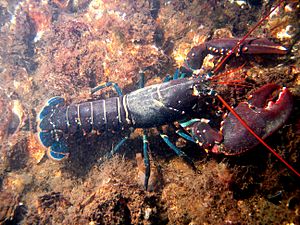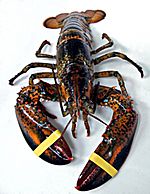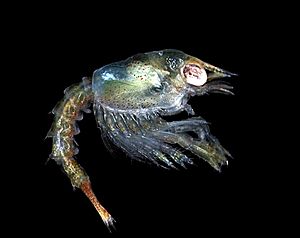Homarus facts for kids
Quick facts for kids Homarus |
|
|---|---|
 |
|
| Homarus gammarus | |
| Scientific classification |
|
| Kingdom: | Animalia |
| Phylum: | Arthropoda |
| Subphylum: | Crustacea |
| Class: | Malacostraca |
| Order: | Decapoda |
| Family: | Nephropidae |
| Genus: | Homarus Weber, 1795 |
| Type species | |
| Astacus marinus Fabricius, 1775
|
|
| Extant species | |
|
H. americanus – American lobster |
|
Homarus is a group of lobsters that includes two very well-known types: the American lobster (Homarus americanus) and the European lobster (Homarus gammarus). These lobsters are important for fishing and food around the world. Another lobster, the Cape lobster, used to be in this group but was moved to its own group called Homarinus in 1995.
Contents
About Homarus Lobsters
Homarus lobsters are special because they have two different kinds of claws. One claw is a strong "crushing" claw, and the other is a sharper "cutting" claw. This is called dimorphism, meaning "two forms." Only a few other types of lobsters have this feature.
Other lobsters that are similar include Nephrops, which are much thinner and have grooves on their claws and body. There's also Homarinus, the Cape lobster from South Africa, which is even smaller and has furry claws.
Scientists have studied the bodies of these lobsters and think Homarinus and Homarus are closely related. However, when they look at their DNA, they find that these two groups are not as closely related as once thought. Both Homarus and Homarinus lobsters do not have sharp spines or ridges on their bodies. Scientists believe they lost these features separately over time, which is called convergent evolution. This means they ended up looking similar but got there in different ways. The closest living relative to Homarus is a lobster called Nephrops norvegicus.
Types of Homarus Lobsters
Even though scientists have found eight types of Homarus lobsters in fossils, only two types are still alive today. These two, the American lobster and the European lobster, look very much alike. They might have become separate types during the Ice Age, when the climate changed a lot.
The easiest way to tell them apart is where they live. The American lobster lives in the western part of the Atlantic Ocean. The European lobster lives in the eastern part of the Atlantic Ocean. Also, the American lobster usually has one or more small teeth on the underside of its "nose" (called a rostrum), while the European lobster does not.
| Image | Scientific Name | Common Name | What They Look Like | Where They Live |
|---|---|---|---|---|
 |
Homarus gammarus | European lobster or common lobster | Can grow up to 60 cm (24 in) long and weigh up to 6 kilograms (13 lb). They have two large claws. When alive, they are usually blue. They only turn red when cooked! These lobsters are a popular food and are caught using special traps. | Mostly around the British Isles and parts of Europe. |
 |
Homarus americanus | American lobster, Atlantic lobster, or Maine lobster | Usually 20–60 cm (8–24 in) long and weigh 0.5–4.1 kg (1.1–9.0 lb). Some can grow much larger, up to 64 cm (25 in) and weigh over 20 kg (44 lb). This makes them the heaviest type of crustacean in the world! | Along the Atlantic coast of North America, from Canada down to North Carolina. |
Ancient Lobster Fossils
Scientists have found fossils of nine different types of Homarus lobsters that are now extinct. Some of these fossils are very old, going back to the time of the dinosaurs. It can be tricky to tell the difference between some ancient Homarus fossils and those from a similar extinct group called Hoploparia.
Where Lobsters Live
Both types of living Homarus lobsters are found in the North Atlantic Ocean. The American lobster (H. americanus) lives along the western side, from Labrador in Canada down to North Carolina in the United States. The European lobster (H. gammarus) lives on the eastern side, from Arctic Norway down to Morocco, including the waters around the British Isles and the Mediterranean Sea.
Life Cycle of Lobsters
The way Homarus lobsters mate is quite interesting. Male lobsters build special shelters or burrows. Bigger males can attract more females, leading to a system where one male mates with several females.
A few days before a female lobster sheds her old shell (this is called moulting), she chooses a mate. She stays in his shelter until she moults. The male then places a packet of sperm (called a spermatophore) inside the female. She can store this sperm for several years!
The female lobster lays her eggs in the autumn. As the eggs come out, they are fertilized by the stored sperm. She carries these eggs under her tail, attached to small leg-like parts called pleopods.
The eggs usually hatch in the spring. They first hatch as a tiny pre-larva, which quickly changes into the first larval stage. After this, they go through three more larval stages called zoea. How long these stages last depends on the water temperature, from two weeks to two months.
After the zoea stages, the young lobster moults again and becomes a post-larva. At this point, it looks much more like an adult lobster. It can swim using its pleopods, but it soon settles down to the bottom. It lives as a young lobster (a juvenile) for about 3 to 5 years.
As lobsters get older and bigger, they moult less often. The size at which they become old enough to reproduce (sexual maturity) changes with temperature. For American lobsters in southern New England, females can reproduce when they are about 70 mm (2.8 in) long. But in colder places like the Bay of Fundy, they need to be about 100 mm (3.9 in) long. For European lobsters, the size for sexual maturity is between 80–140 mm (3.1–5.5 in).
Images for kids
See also
 In Spanish: Bogavante para niños
In Spanish: Bogavante para niños



